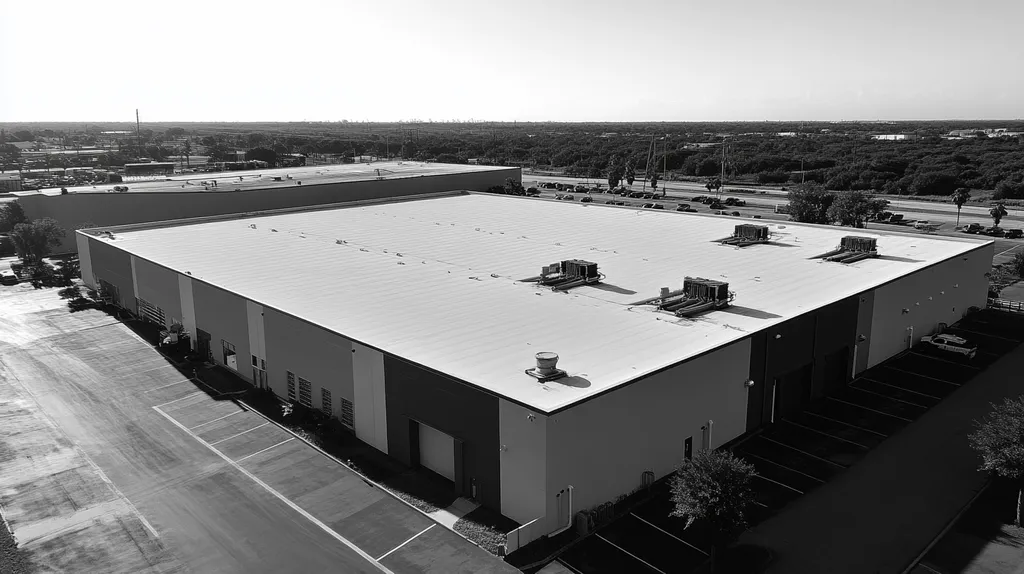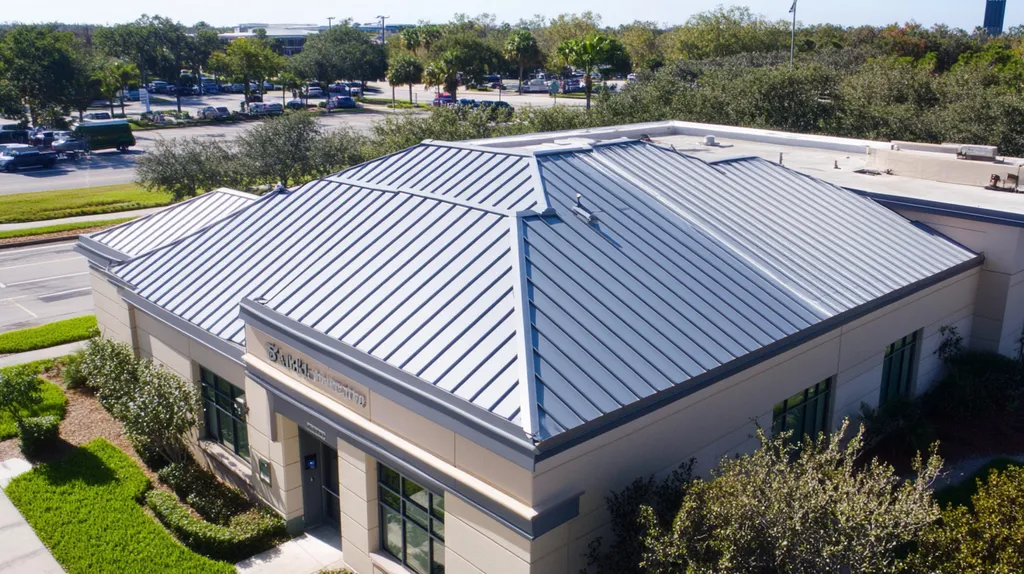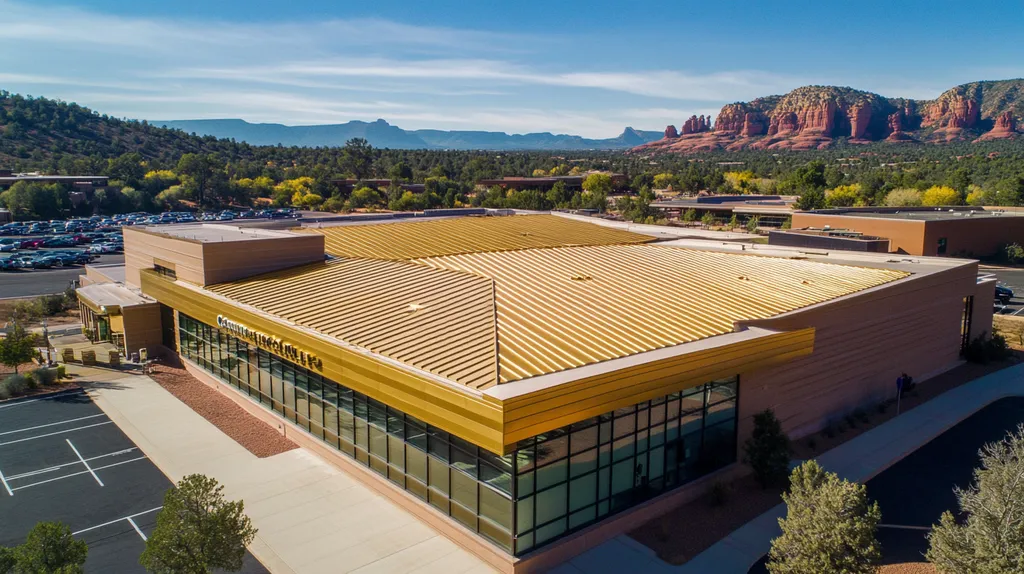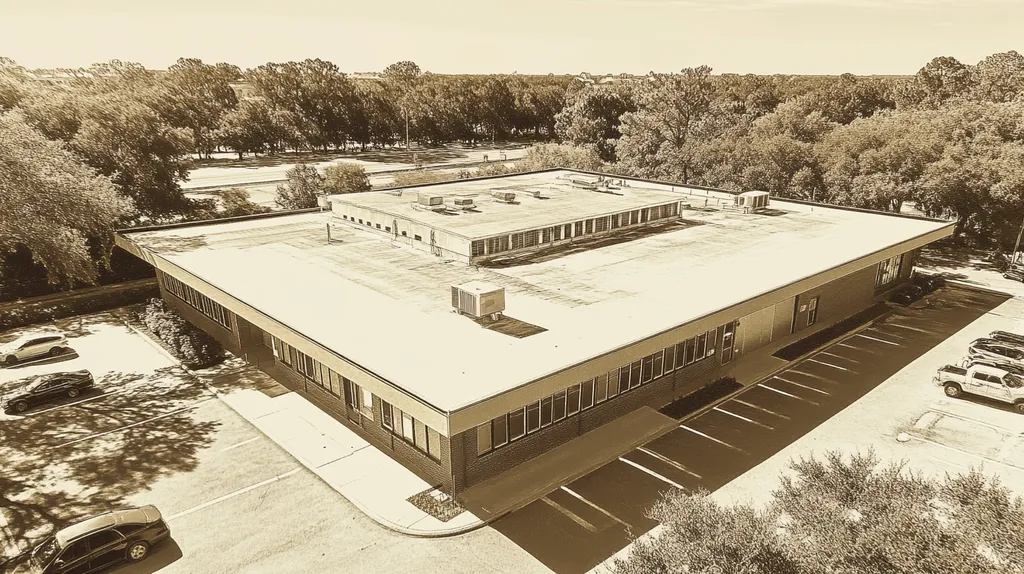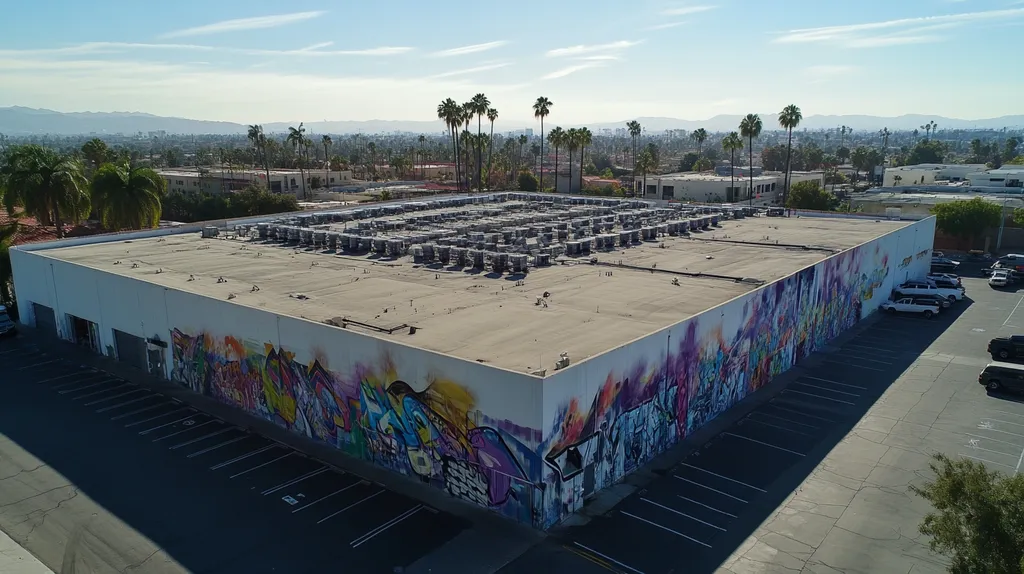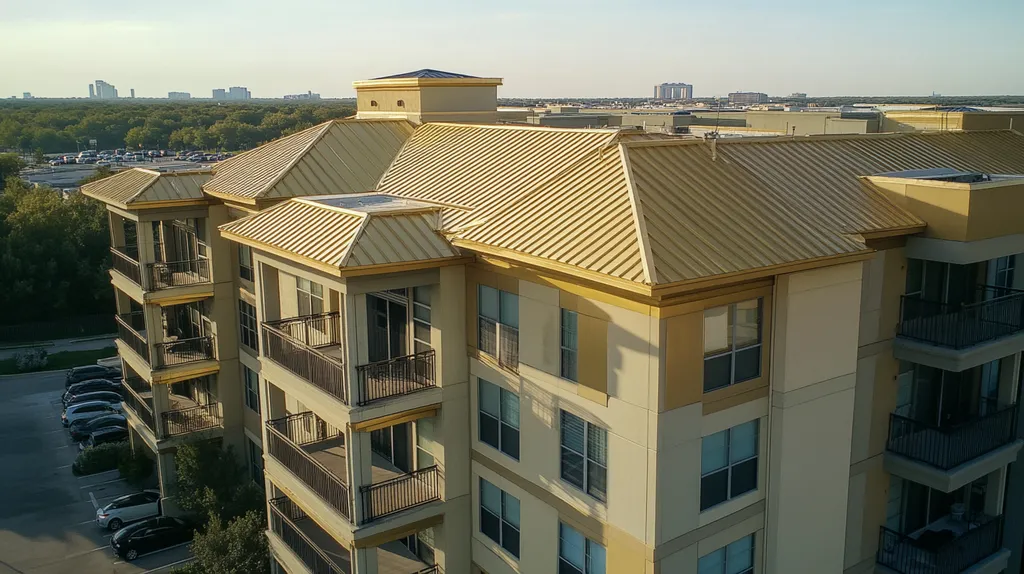Temperature fluctuations threaten the integrity of commercial roof coatings, with studies showing up to 40% reduction in coating lifespan due to extreme thermal cycling. These variations can lead to premature failures, costly repairs, and compromised building protection.
For facility managers and property owners, understanding how temperature changes impact coating performance is crucial for protecting their substantial roofing investments, which often exceed $500,000 for large commercial buildings.
This comprehensive guide examines the critical factors affecting coating durability, financial implications, compliance requirements, risk management strategies, and operational procedures necessary for maintaining optimal roof performance despite temperature challenges.
SECTION 1: PERFORMANCE FACTORS
When it comes to commercial roof coatings, temperature fluctuations can spell trouble. As these coatings shift with changing temperatures, facility managers and property owners face the risk of early failures and costly repairs. Alarmingly, poor temperature control can shorten a roof’s lifespan by as much as 30%. Being aware of these performance factors is crucial for ensuring commercial roofs remain in good condition and perform effectively.
Material Expansion and Contraction
Every roofing material undergoes a natural process of expansion and contraction due to temperature variations. This movement can strain roof coatings, often resulting in cracks or gaps. For example, when single-ply membranes heat up, they stretch—but they might not contract effectively when temperatures cool down.
When a coating can’t handle this kind of movement, delamination can occur, which is when the coating separates from the surface below. This separation can threaten insulation performance and expose the underlying structure to water damage. Regular inspections can help catch these early symptoms before they escalate.
To minimize these issues, choosing high-quality materials that are specifically tailored to the local climate is essential. Coatings designed for flexibility and elongation better manage these stresses, enhancing long-term performance significantly.
Key Action Items
Thermal Shock Impact on Coatings
Thermal shock can happen when sudden temperature changes affect a roof’s surface. For instance, when a cold front swiftly follows a warm period, coatings may struggle to adjust. This shock can lead to surface cracking and peeling, significantly reducing the coating’s effectiveness.
These failures can have a notable impact on energy efficiency, driving up utility costs. Studies show that buildings with compromised roof coatings often experience increased heating and cooling expenses due to poor insulation performance.
Choosing coatings that reflect solar energy and include thermal resistance can help combat these thermal shock effects. Reflective materials not only lower energy costs but also enhance the lifespan of the roofing system.
Key Action Items
Roof System Integrity
The performance of roof coatings plays a critical role in the overall integrity of the roof system. Without proper maintenance, minor issues from temperature fluctuations can snowball into major structural failures.
Compromised coatings can lead to moisture infiltrating the roof, weakening insulation and other structural elements. This risk highlights the importance of regular maintenance and prompt repairs.
Facility managers should develop a robust maintenance program that includes assessments specifically focused on coating performance. Consistent inspections and proactive repairs are crucial in safeguarding the roof’s integrity.
Key Action Items
SECTION 2: FINANCIAL CONSIDERATIONS
Understanding the financial implications of roof coatings is crucial for facility managers and commercial property owners. With around 30% of roofs failing prematurely due to extreme temperature fluctuations, repair and replacement costs can escalate quickly. By investing in quality roof coatings, property owners can mitigate these risks, lower lifecycle costs, and improve energy efficiency. This section addresses the costs associated with roof repairs and replacements, the potential long-term savings from effective coatings, and budgeting strategies for preventive maintenance.
Cost of Roof Repairs and Replacement
The expense of roof repairs and replacements can be staggering, especially for commercial buildings. On average, roof replacements can range from $5,000 to $30,000 depending on the size and materials used. Weather damage and inadequate maintenance can cause these expenses to soar.
Facility managers may also incur costs from lost business operations during extensive roof repairs. For instance, a leaking roof could damage inventory or equipment, leading to unexpected downtimes that hurt profitability.
As temperature fluctuations hasten the deterioration of roofing materials, frequent repairs can eclipse the initial costs of installing a quality roof coating. Thus, recognizing these costs is essential for making sound financial decisions in roofing investments.
Choosing a robust roof coating from the start can significantly reduce the chances of costly repairs related to extreme temperature changes. This proactive investment pays off long-term.
Long-Term Savings with Coatings
Incorporating roof coatings into a comprehensive roofing strategy can lead to considerable long-term savings for facility managers. High-quality coatings can reflect heat, significantly reducing the energy required for cooling during warmer months, resulting in lower utility bills—potentially saving up to 30% annually.
Additionally, effective roof coatings can enhance the lifespan of the underlying roof material. Instead of replacing a roof every 15-20 years, a premium coating can extend its life by an extra decade, deferring substantial capital expenditures.
Many of these coatings also come with warranties that guarantee their performance, adding a layer of financial protection. This assurance allows facility managers to rely on the durability and effectiveness of their investment.
By closely evaluating the costs and potential savings associated with roof coatings, property owners can make informed decisions that align with their financial goals.
Budgeting for Preventive Maintenance
Effectively managing roof coatings requires thoughtful planning for preventive maintenance. Allocating funds for regular checks can help spot issues before they evolve into costly repairs. A budget that prioritizes ongoing inspections ensures the roof’s resilience against temperature fluctuations.
Facility managers should develop a maintenance schedule that includes annual inspections and timely repairs to prolong the roof’s life. This proactive approach reduces the risk of failure and supports operational efficiency.
Emergency repairs often carry a higher price tag than routine maintenance. With careful budgeting, property owners can avoid unexpected costs, ensuring their roofing assets remain in optimal condition.
Ultimately, a well-structured budget not only preserves the roof’s integrity but also safeguards the financial health of the entire organization.
SECTION 3: COMPLIANCE REQUIREMENTS
Compliance with regulatory standards is vital for the performance of commercial roof coatings, especially when facing temperature fluctuations. Not only can non-compliance lead to costly repairs and potential legal issues, but it can also reduce energy efficiency by up to 30%. Understanding compliance requirements helps facility managers and property owners make informed decisions that enhance both building safety and sustainability.
Regulatory Standards for Roofing
Compliance with industry-specific regulatory standards lays the groundwork for effective roof performance. Regulatory bodies like the Occupational Safety and Health Administration (OSHA) and local building codes provide essential guidelines that ensure roofing materials can withstand temperature changes and environmental stressors.
The International Building Code (IBC) outlines requirements related to roof design and thermal performance. By following these standards, facility managers not only avoid legal penalties but also enhance the overall safety of the building.
Neglecting compliance can lead to shorter lifespans for roofing materials and an increase in replacement cycles, which ultimately results in higher long-term costs. Regular compliance audits are critical in mitigating these risks.
Key Action Items
Energy Efficiency Codes and Coatings
Energy efficiency codes are crucial when selecting roof coatings, as they mandate specific standards for thermal resistance and reflectivity. Legislation like the Energy Policy Act, along with local codes, guides property owners in ensuring their roofs minimize energy consumption and operational costs.
For example, the cool roof standard necessitates materials that reflect more sunlight and absorb less heat, making it especially important in warmer climates. Non-compliance with these codes can lead to increased energy expenses and may compromise the roof’s performance under extreme temperature variations.
Facility managers should opt for coatings that meet or exceed these energy efficiency standards to prevent wasted energy and unnecessary costs.
Key Action Items
Certification and Inspection Requirements
Certification and inspection are key processes for validating the quality and performance of roof coatings. Organizations like the Cool Roof Rating Council (CRRC) provide crucial certifications that test the thermal and reflective capabilities of roofing materials—ensuring compliance with energy standards.
Regular inspections are equally important for detecting any potential issues early, especially those arising from temperature changes that could compromise coating performance. Routine checks can help identify failures before they escalate into significant problems.
Facility managers should prioritize scheduling inspections at least twice a year and maintain comprehensive documentation, which can be crucial for warranty claims if issues arise.
Key Action Items
SECTION 4: RISK MANAGEMENT
The unpredictable nature of temperature fluctuations can present serious challenges for commercial roof coatings. If overlooked, these temperature swings may create potential leak points, resulting in costly water damage and structural deterioration. Long-term exposure can compromise the integrity of a building, emphasizing the need for proactive risk management strategies to safeguard valuable investments. This section introduces essential approaches for identifying risks, mitigating moisture, and managing snow and ice accumulation.
Identifying Potential Leak Points
Facility managers must prioritize identifying potential leak points across their roofs. Key areas of concern include roof penetrations, seams, and flashing installations, which are often the most vulnerable to leaks. Conducting annual inspections, aided by thermal imaging technology, can help to uncover hidden vulnerabilities that aren’t visible during standard assessments.
Employing drones or infrared cameras can streamline the inspection process, especially for expansive facilities. These advanced tools can detect temperature anomalies indicating moisture penetration or insulation degradation. Addressing these potential leak points early is crucial for maintaining the integrity of the coating and prolonging the roof’s lifespan.
Furthermore, inspecting gutters and drainage systems is vital. Clogged drainage can lead to water pooling, significantly increasing the risk of leaks. Routine maintenance of these systems helps minimize water exposure on roof surfaces, reducing potential leak points.
Key Action Items
Mitigating Moisture and Condensation
Moisture and condensation can be significant threats to the performance of roof coatings. Fluctuating temperatures may result in moisture buildup beneath roof surfaces, creating conditions for mold, mildew, and weakening roofing materials. Addressing moisture effectively is crucial for extending the lifespan of the roofing system.
Installing vapor barriers is an effective and proactive measure to prevent moisture infiltration. These barriers restrict moisture from penetrating roofing materials, thus safeguarding the roof coating. Facility managers should assess the climate and roof design while selecting appropriate vapor barrier materials.
Additionally, ensuring proper ventilation in roofing systems is essential. Adequate airflow helps reduce moisture buildup by allowing fresh air to circulate and keeping surfaces dry. Regular inspections and maintenance of ventilation systems are necessary to maximize their effectiveness in managing moisture.
Key Action Items
Managing Snow and Ice Accumulation
Snow and ice accumulation can create distinct challenges for commercial roofing systems. The added weight of snow can stress roof structures, risking deformation and potential failure. Ice damming is particularly problematic, as it can cause water to back up under roofing materials, increasing the likelihood of leaks.
Implementing an effective snow removal strategy is crucial to maintaining roof integrity. Facility managers should prioritize snow removal after significant snowfall, focusing on high-risk areas like overhangs and flat sections. Using shovels or specialized snow removal tools can minimize damage to coatings compared to heavy machinery.
Additionally, installing heating cables along roof edges can effectively prevent ice dams. These cables melt snow and ice, allowing water to drain efficiently and reducing leak risks. A solid understanding of thermal dynamics can guide placement for optimal effectiveness.
Key Action Items
SECTION 5: OPERATIONAL PROCEDURES
Temperature fluctuations pose increasing challenges for facility managers, jeopardizing the effectiveness of roof coatings. A notable survey from 2018 revealed that 70% of commercial properties experienced premature coating failures due to lack of temperature control. By implementing comprehensive operational procedures, facility managers can significantly extend the lifespan of roof coatings and ensure consistent performance. This section highlights essential practices to mitigate temperature-induced issues.
Regular Inspection and Maintenance
Consistent inspections are vital for catching potential issues before they escalate into larger problems. Facility managers should schedule biannual evaluations focusing on areas prone to extreme temperature variations. During these assessments, trained professionals should check for indicators of wear, such as cracks, peeling, or blistering, as these can signal compromised coatings.
Creating a preventive maintenance program can maintain roofs in peak condition. Routine tasks should include cleaning debris, inspecting drainage systems, and addressing minor repairs. Regular attention to these areas can prevent moisture buildup and subsequent thermal expansion, enhancing the roof’s longevity.
Maintaining thorough documentation of inspections and maintenance activities is essential. This record will help track the roof’s condition over time and assist in long-term capital planning decisions. Regular maintenance prevents significant thermal damage, which can lead to costly repairs and extended downtime.
Key Action Items
Application of Elastomeric Coatings
Elastomeric coatings are an effective solution for roofs subjected to temperature fluctuations. These coatings offer excellent properties for thermal expansion and contraction, enabling them to endure extreme temperature variations without cracking. Choosing high-quality elastomeric coatings can significantly bolster the roof’s overall durability.
The success of these coatings hinges on proper application. Facility managers must ensure trained professionals apply the coatings following manufacturer guidelines. Factors such as ambient temperature, humidity levels, and surface preparation play crucial roles in adhesion and performance. Neglecting these considerations can lead to premature coating degradation.
Applying coatings during mild weather conditions optimizes performance, as extreme temperatures can adversely affect curing times and adhesion. Regular evaluations after application are also key, as checking for common wear indicators allows timely intervention before minor issues escalate into more serious concerns.
Key Action Items
Seasonal Preparation and Monitoring
Keeping an eye on seasonal changes is crucial for maintaining the performance of roof coatings over time. As temperatures shift, roofs may encounter distinctive challenges that threaten coating integrity. Implementing a seasonal preparation checklist allows facility managers to proactively address potential issues.
Before extreme weather hits, facility managers should prepare roofs by conducting extra cleaning, reinforcing seams, and addressing minor repairs. Ensuring roofs are ready for seasonal changes protects coatings from unnecessary stress and damage.
Monitoring temperature trends throughout the year and adjusting maintenance practices accordingly is equally important. Familiarity with local climate patterns enables managers to anticipate issues and plan interventions effectively, such as scheduling coating inspections after severe winter conditions. Having a clear response plan for extreme weather events also mitigates damage risks.
Key Action Items
SECTION 5: OPERATIONAL PROCEDURES
Temperature fluctuations present significant challenges for facility managers, as these variations can undermine the efficacy of roof coatings. A concerning statistic from 2018 indicated that 70% of commercial properties faced premature coating failures due to insufficient temperature management. By implementing robust operational procedures, facility managers can greatly prolong the life of roof coatings and maintain consistent performance. This section outlines critical practices designed to mitigate temperature-related issues.
Regular Inspection and Maintenance
Regular inspections are vital for identifying potential issues before they develop into major problems. Facility managers should schedule biannual evaluations, emphasizing areas that are particularly susceptible to extreme temperature variations. During these inspections, professionals should look for signs of wear such as cracking, peeling, or blistering, which could indicate compromised coatings.
Creating a preventive maintenance program can help maintain roofs in peak condition. Routine tasks should include cleaning debris, checking drainage systems, and addressing minor repairs, all of which can minimize moisture buildup and thermal expansion, thus extending the roof’s life.
Keeping thorough documentation of inspections and maintenance activities is crucial for tracking the roof’s condition over time. This record can be invaluable when making long-term capital planning decisions. Inadequate inspections can lead to significant thermal damage, emphasizing the need for proactive measures to mitigate repair costs and extend service life.
Key Action Items
Application of Elastomeric Coatings
Elastomeric coatings provide an effective solution for roofs subjected to temperature fluctuations. These coatings are engineered to expand and contract, allowing them to withstand extreme temperature changes without cracking. Choosing high-quality elastomeric coatings can substantially improve the overall durability of the roof.
The success of these coatings hinges on proper application. Facility managers should ensure that trained professionals apply the coatings per manufacturer specifications. Key factors such as temperature, humidity, and surface preparation impact adhesion and performance, so attention to these details is critical.
Additionally, the application should occur during moderate weather to maximize performance. Extreme temperatures can negatively influence curing times and adhesion properties, leading to premature failures. Regular evaluations post-application are also essential to catch potential wear indicators early.
Key Action Items
Seasonal Preparation and Monitoring
Keeping an eye on seasonal changes is essential for maintaining the performance of roof coatings. As temperatures fluctuate, roofs may experience specific challenges that threaten coating integrity. Implementing a seasonal preparation checklist enables facility managers to proactively address these potential issues.
Before extreme weather arrives, facility managers should prepare roofs by conducting thorough cleaning, reinforcing seams, and addressing minor repairs. Ensuring roofs are ready for seasonal shifts helps protect coatings from unnecessary stress and potential damage.
Monitoring temperature trends throughout the year and adjusting maintenance practices accordingly is also crucial. An understanding of local climate patterns allows managers to anticipate problems and plan interventions effectively. Having a well-defined response plan for severe weather ensures swift action can be taken to protect both investments and safety standards.
Key Action Items
Looking Ahead
With 40% of commercial roofs failing prematurely due to temperature-related stress, the stakes for proper coating management have never been higher.
The financial impact is staggering, as inadequate temperature control leads to an average of $2.40 per square foot in additional maintenance costs annually.
Facility managers must prioritize three critical areas: implementing comprehensive inspection protocols, selecting appropriate temperature-resistant coatings, and maintaining detailed documentation of all maintenance activities.
The future of commercial roofing depends on proactive management strategies that address temperature fluctuations through advanced materials and systematic monitoring.
By following the guidelines outlined in this comprehensive checklist, property owners can significantly extend their roof’s lifespan while reducing long-term operational costs.
FREQUENTLY ASKED QUESTIONS
Q. How do temperature fluctuations affect commercial roof coatings?
A. Temperature fluctuations can cause expansion and contraction in roof coatings, leading to cracks and gaps. This can result in premature failures and costly repairs, ultimately shortening the roof’s lifespan significantly. Regular inspections help identify early signs of damage to prevent larger issues down the line.
Q. What costs are associated with repairing industrial roofs?
A. Repairing industrial roofs can be expensive, often ranging from thousands to tens of thousands of dollars. Frequent repairs from temperature-related damage can be even more costly, leading to increased maintenance expenses and potential operational disruptions. Investing in high-quality roof coatings can mitigate these repair costs significantly over time.
Q. What are regulatory standards for commercial roofs?
A. Regulatory standards outline the requirements for roofing materials, ensuring they can withstand environmental stressors, including temperature changes. Compliance with local building codes and safety guidelines is vital for the performance of the roof and avoiding legal repercussions, helping enhance overall building safety.
Q. How can I identify potential leak points in my commercial roof?
A. Identifying potential leak points involves inspecting vulnerable areas such as roof penetrations and seams. Utilizing advanced tools like thermal imaging can help uncover hidden vulnerabilities. Routine inspections and documenting findings are key to catching issues before they escalate into significant problems.
Q. How can I manage moisture in roof coatings?
A. Managing moisture involves installing vapor barriers to prevent moisture infiltration and ensuring proper ventilation in the roof system. These measures help minimize moisture buildup that can lead to mold or material degradation, ultimately extending the lifespan of the roof coating.
Q. What are effective operational procedures for maintaining roof coatings?
A. Effective operational procedures include regular inspections, applying high-quality elastomeric coatings, and preparing roofs for seasonal changes. Establishing a preventive maintenance program ensures timely identification of issues and supports optimal performance, significantly extending the life of the roof coatings.
Q. What should I include in my seasonal roof preparation checklist?
A. Your seasonal preparation checklist should include cleaning the roof, reinforcing seams, and addressing minor repairs. It’s also essential to monitor temperature trends and schedule inspections after extreme weather events to ensure the roof remains in optimal condition throughout the changing seasons.

